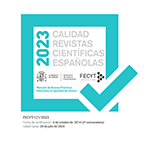For a semiotic art : “de-habituation” and “discontinuity” in argentine art of the sixties and seventies
Abstract
The text analyzes the semiotic focus of the avant-garde practices in Argentina during the sixties. These practices, inspired on the studies of authors such as Roland Barthes, were articulated around concepts like “discontinuity” and “de-habituation” to give rise to a series of highly innovative approaches in the context of international emergence of conceptual art. Proposals from artists and intellectuals such as Ricardo Carreira, Roberto Plate or Oscar Masotta allowed to address the relationships between art and language from a new perspective, which shows connection points, but also deep differences, with the works of conceptual artists in United States and Britain, usually associated with the tautological canon of dematerialized practices. That linguistic analysis was accompanied, in the case of Argentina, with a critique of the media. This is one of the most unique features of the vanguard of the moment and led to collective experimentation between art and communication as the group “Art of the media “, composed Massota own , artists Roberto Jacoby and Eduardo Costa and journalist Juan Risuleo.Downloads
Article download
License
In order to support the global exchange of knowledge, the journal Arte, Individuo y Sociedad is allowing unrestricted access to its content as from its publication in this electronic edition, and as such it is an open-access journal. The originals published in this journal are the property of the Complutense University of Madrid and any reproduction thereof in full or in part must cite the source. All content is distributed under a Creative Commons Attribution 4.0 use and distribution licence (CC BY 4.0). This circumstance must be expressly stated in these terms where necessary. You can view the summary and the complete legal text of the licence.










